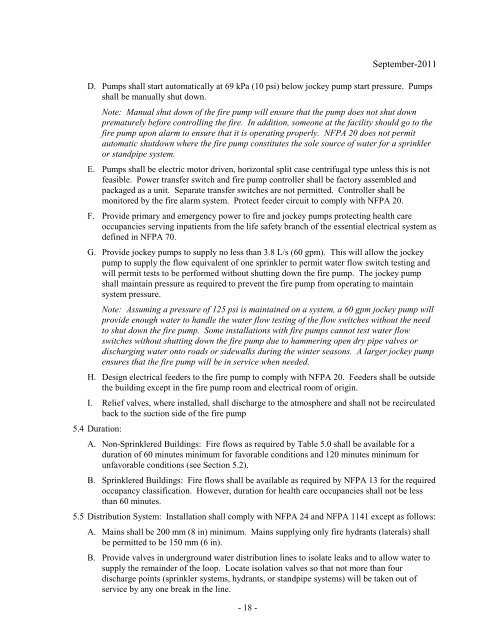Fire Protection Design Manual - Office of Construction and Facilities ...
Fire Protection Design Manual - Office of Construction and Facilities ...
Fire Protection Design Manual - Office of Construction and Facilities ...
You also want an ePaper? Increase the reach of your titles
YUMPU automatically turns print PDFs into web optimized ePapers that Google loves.
September-2011<br />
D. Pumps shall start automatically at 69 kPa (10 psi) below jockey pump start pressure. Pumps<br />
shall be manually shut down.<br />
Note: <strong>Manual</strong> shut down <strong>of</strong> the fire pump will ensure that the pump does not shut down<br />
prematurely before controlling the fire. In addition, someone at the facility should go to the<br />
fire pump upon alarm to ensure that it is operating properly. NFPA 20 does not permit<br />
automatic shutdown where the fire pump constitutes the sole source <strong>of</strong> water for a sprinkler<br />
or st<strong>and</strong>pipe system.<br />
E. Pumps shall be electric motor driven, horizontal split case centrifugal type unless this is not<br />
feasible. Power transfer switch <strong>and</strong> fire pump controller shall be factory assembled <strong>and</strong><br />
packaged as a unit. Separate transfer switches are not permitted. Controller shall be<br />
monitored by the fire alarm system. Protect feeder circuit to comply with NFPA 20.<br />
F. Provide primary <strong>and</strong> emergency power to fire <strong>and</strong> jockey pumps protecting health care<br />
occupancies serving inpatients from the life safety branch <strong>of</strong> the essential electrical system as<br />
defined in NFPA 70.<br />
G. Provide jockey pumps to supply no less than 3.8 L/s (60 gpm). This will allow the jockey<br />
pump to supply the flow equivalent <strong>of</strong> one sprinkler to permit water flow switch testing <strong>and</strong><br />
will permit tests to be performed without shutting down the fire pump. The jockey pump<br />
shall maintain pressure as required to prevent the fire pump from operating to maintain<br />
system pressure.<br />
Note: Assuming a pressure <strong>of</strong> 125 psi is maintained on a system, a 60 gpm jockey pump will<br />
provide enough water to h<strong>and</strong>le the water flow testing <strong>of</strong> the flow switches without the need<br />
to shut down the fire pump. Some installations with fire pumps cannot test water flow<br />
switches without shutting down the fire pump due to hammering open dry pipe valves or<br />
discharging water onto roads or sidewalks during the winter seasons. A larger jockey pump<br />
ensures that the fire pump will be in service when needed.<br />
H. <strong>Design</strong> electrical feeders to the fire pump to comply with NFPA 20. Feeders shall be outside<br />
the building except in the fire pump room <strong>and</strong> electrical room <strong>of</strong> origin.<br />
I. Relief valves, where installed, shall discharge to the atmosphere <strong>and</strong> shall not be recirculated<br />
back to the suction side <strong>of</strong> the fire pump<br />
5.4 Duration:<br />
A. Non-Sprinklered Buildings: <strong>Fire</strong> flows as required by Table 5.0 shall be available for a<br />
duration <strong>of</strong> 60 minutes minimum for favorable conditions <strong>and</strong> 120 minutes minimum for<br />
unfavorable conditions (see Section 5.2).<br />
B. Sprinklered Buildings: <strong>Fire</strong> flows shall be available as required by NFPA 13 for the required<br />
occupancy classification. However, duration for health care occupancies shall not be less<br />
than 60 minutes.<br />
5.5 Distribution System: Installation shall comply with NFPA 24 <strong>and</strong> NFPA 1141 except as follows:<br />
A. Mains shall be 200 mm (8 in) minimum. Mains supplying only fire hydrants (laterals) shall<br />
be permitted to be 150 mm (6 in).<br />
B. Provide valves in underground water distribution lines to isolate leaks <strong>and</strong> to allow water to<br />
supply the remainder <strong>of</strong> the loop. Locate isolation valves so that not more than four<br />
discharge points (sprinkler systems, hydrants, or st<strong>and</strong>pipe systems) will be taken out <strong>of</strong><br />
service by any one break in the line.<br />
- 18

















